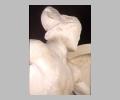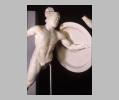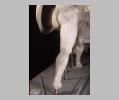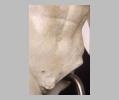
Aegina E 2 and E 3, Right Champion and Opponent of East Ped. 2, full front...

Aegina E 2, Right Champion of East Ped. 2, upper torso, from right

Aegina E 2, Right Champion of East Ped. 2, torso, from right

Aegina E 2, Right Champion of East Ped. 2, back of leg

Aegina E 2, Right Champion of East Ped. 2, lower torso, frontal view, from...

Aegina E 2, Right Champion of East Ped. 2, full figure profile, view facin...
| Collection: | Munich, Glyptothek |
| Title: | Aegina, E. Ped. 2, fig. E 2: Right Champion, Priam (?) |
| Context: | From Aegina, Sanctuary of Aphaia |
| Findspot: | Excavated at Aegina, Sanctuary of Aphaia |
| Summary: | Champion Warrior to right of Athena, possibly Priam |
| Material: | Marble |
| Sculpture Type: | Architectural |
| Category: | Statuary group |
| Placement: | East pediment 2 |
| Style: | Late Archaic |
| Date: | ca. 490 BC - ca. 480 BC |
| Dimensions: | H 1.37 m |
| Scale: | Life-size |
| Region: | Saronic Gulf |
| Period: | Late Archaic |
| In Group: | Aegina East Pediment 2 |
Subject Description:
The Champion Warrior to the right of Athena faces his opponent. His feet are set extremely far apart to give the maximum amount of force to his thrust. He is winning his one-on-one battle. His right leg forms a continuous diagonal with the torso of his body and his head. The leg is straight but not rigid, the knee not locked, giving a slight curve and a high degree of naturalism to the figure. The right arm is pulled sharply back in preparation for the thrust. It echoes the diagonal of the leg and counters its curve with a slight one of its own. Most of the weight actually rested on the bent right leg, now missing but largely reconstructed from the character of the break. The figure wears a Corinthian helmet and carries a shield, but has no other body armor. Because the lower part of his right hand is broken away, his weapon — either a lance or a sword — cannot be identified. The figure is shown in as pure a profile as any in the East Pediment, yet has depth. The right arm pulls the torso around with it, bringing the left shoulder and arm fully into view. A fragment of shield attached to the left shoulder shows that, in this case, the shield and figure were carved from the same block of marble. Some details such as the shield-stay were added. Four holes in the left forearm indicate where it was attached. The inside of the shield would have been painted, causing the arm to stand out against it. The head, in Athens with a cast in Munich, was formerly attributed to the earlier set of pediments. The neck break was altered by Thorvaldsen in the 19th century, but an extant cast made prior to that restoration proves that the head belongs.
If Athena's gesture is correctly interpreted as a threat directed specifically at this warrior, the champion must be a Trojan. Since this pediment depicts the earlier Trojan war against King Laomedon, and Priam is the only one of his sons to survive the arrows of Herakles in that campaign, Ohly's identification of this figure as Priam would seem to have merit. Both his prominent position near Athena and his youth would be fitting in this context.
No part of the plinth is preserved for this figure, although the horizontal geison blocks for this area have survived. However, in addition to the evidence provided by his pose and height, a drawing made by the Cockerell party in 1811 recorded the relative find spots in front of the East Pediment of the five principal figures. E2 is one of those recorded and his position thus confirmed. The drawing is reproduced by Ohly.
Form & Style:
In pose the Champion E 2 does not differ greatly from the analogous warrior in the West Pediment. The impression he creates, however, is of a more powerful figure. As with the East Athena, the widely-spaced feet give a greater degree of intensity to the action. The forward thrust of the weapon carries the full mass of his body behind it, the weight coming to rest on the bent left knee. With one less figure in each side of the pediment, the pose is clear to the viewer, unclouded by any overlapping figures. Yet the champion is not only linked with his immediate opponent, but intimately connected with the figure beyond. The strong diagonals formed by their lunging bodies appear as the legs of a triangle, giving a greater cohesiveness to the composition of the pediment as a whole. The fact that the head, until recently, was assigned to the earliest pediments indicates that the stylistic development of all figures is not necessarily even, for the torso of the champion is clearly more stylistically advanced than the schematically rendered chests and abdomens of many of the West Pediment figures. Based on similarities of treatment, Ohly assigned E2 and E3 to the same hand.
Date Description:
.
Condition: Nearly complete
Condition Description:
Missing left leg and the better part of the hands and feet. The torso, in Munich, was one of those restored by Thorvaldsen. Casts of the later finds, in Aegina, have permitted reconstruction of the right arm and leg. The head, in Athens, was originally attributed to the earlier pediments. Its current attribution to this figure is assured by a join with a 19th century cast of the torso taken prior to its restoration, before the neck was altered.
Material Description:
Parian Marble
Associated Building: Aegina, Temple of Aphaia